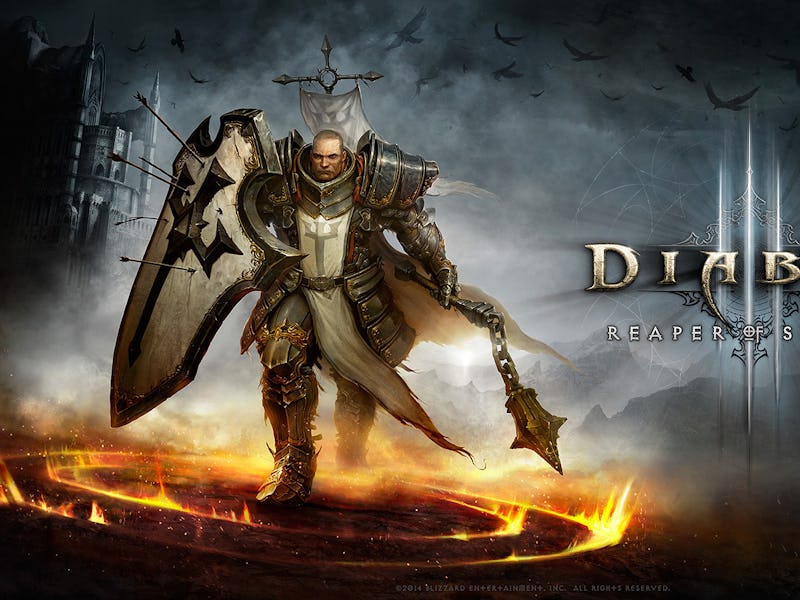'Diablo III' Used to Suck. Here's How It Got Good.
Blizzard's action role-playing game was maligned at release. But now it's a classic.

Maybe you dismissed Diablo 3 when it came out. Maybe you played it and found it weaker than its peers, or just heard its bad reputation. Fair enough — it had problems. But three years, one expansion pack, and several patches later, D3 has shed or minimized its problems, while accenting its best parts. It’s utterly fantastic right now, and if you haven’t played ever, or since the Reaper of Souls expansion and Adventure Mode came out, you owe it to yourself to give it a shot.
Now’s an especially good time to get (back) into Diablo 3. Here’s why:
You can jump in immediately
Diablo 3 has instituted a new concept called “seasons” which are essentially excuses to create brand-new characters in the game world for extra bonuses. None of the existing items, upgrades, or gold carries over, so everyone starts in the same position. (And at the end of the months-long season, characters get integrated into your regular stable).
The new season — the fifth — just dropped in mid-January, alongside Patch 2.4.0.
The story doesn’t matter anymore
The plot of Diablo 3 actively worked against the game’s strengths on release. It tried to tell a story in-the-now without giving players agency, and backfired constantly. But, if you’re playing it right, it’s gone now.
The game’s later Adventure Mode addition fixed this by, well, getting rid of the story. Diablo 3 is at its best when you’re in a constant fight-loot-upgrade loop, and that’s what Adventure Mode is. It gives players enough structure to serve as motivation with five quests in each part of the world, but largely just says “head out and fight.” It’s unfortunate that Adventure Mode is still gated behind completing the story through Act V, so you have to complete the story once, but it’s worth it to blast through.
Meanwhile, for advanced challenges, the game introduced “Rifts” which send players into randomized dungeons with tougher and tougher bosses, and more straight-up fighting. Moment-to-moment combat always felt good in Diablo 3, and now, the game is about that, and not the other bullshit getting in the way. Speaking of which …
The Auction House is gone, and loot works
Initially Diablo 3 was designed with an Auction House where, using in-game money or real world money, players could buy and sell their loot. But items were also super specialized, so 90% of what you found in-game was useless, making the Auction House the best way to improve. And the problem with that was the core motivations for playing — kill tough enemies, get better gear — were ruined by motivating players to just collect gold.
But the Auction House is gone now, and “Loot 2.0” changed the system so that the items that drop are likely for your character. Now, there’s no longer a constant feeling of “I’m playing this wrong” while during a normal game.
Always-online isn’t broken
The biggest black eye given to Diablo 3’s reputation was that it was an always-online game that, at launch, couldn’t keep its servers up. This hasn’t been an issue since that first week. Not a surprise, but worth noting!
The role-playing aspects work
Diablo 3 took some heat from RPG fans when it came out for not really being a pure role-playing game, with stats being granted automatically and skills being changeable at any point. Those are both still true, and Torchlight 2 is definitely still a better traditional experience.
Magic items are now the key to 'Diablo 3's progression
Instead, Diablo 3 has improved in two ways. First, leveling up is significantly faster now, especially in Adventure Mode, so you have more, better options. Second, it’s shifted its character customization options to items. Find a weapon that enhances lightning damage, for example, and suddenly you have reason to shift to as many lightning skills as you can get. It’s simple and satisfying in a way that turns a once-major weakness into a bit of a strength.
The difficulty works
Originally, Diablo 3 was set to a rigid progression system, where you played through the game on Normal, then Hard, etc. Problem was, it escalated too quickly and unfairly, particularly against melee characters. Now? The goal of the game is to keep you engaged, not frustrated. Difficulty is set by the player: if it gets too easy, leave the game and raise it; if it gets too hard, you don’t even need to leave, it lets you lower difficulty from right in the game.
This takes some getting used to from new players, especially those who are used to setting and forgetting difficulty. But it’s how D3 is meant to be played, and is a dramatic improvement.
"Increase the difficulty" is how you play the game these days.
There’s new stuff!
Last year a patch added the new zone “The Ruins of Sescheron” which instantly became one of Diablo 3’s best levels, with a great combination of music, backstory, and level design. The newest patch has even more levels, which aren’t quite at the same highest standard, but they are still good to see.
What’s more, there are new quest styles for Adventure Mode, adding a constant stream of variety into something built around repetition. Recent patches also added a new item and game mechanic called “Kunai’s Cube.” More than simply a remake of Diablo 2’s “Horadric Cube,” Kunai’s adds a level of item development to the late-game, with all sorts of options for improvement beyond the initial “hope for good loot” plan. It turns into a meta-game system that ties much of the rest of the vastly-improved Diablo 3 together.
So go on. Whether you felt jilted before, or are curious now, hook up with Diablo 3. And try the Crusader if you haven’t, it’s the best class.